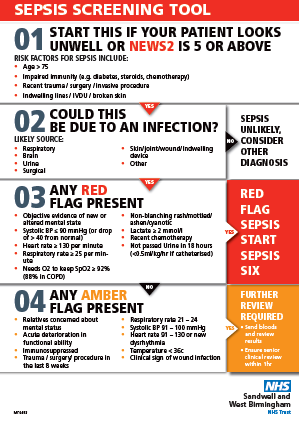Understanding, Screening and Treating Sepsis
March 31, 2022
 Sepsis is a condition caused by the body’s immune system responding abnormally to an infection, which can lead to tissue damage, organ failure, and death. The infection can start anywhere in the body; it may be only in one part, or it may be widespread.
Sepsis is a condition caused by the body’s immune system responding abnormally to an infection, which can lead to tissue damage, organ failure, and death. The infection can start anywhere in the body; it may be only in one part, or it may be widespread.
The immune system usually works to fight any germs (bacteria, viruses, fungi), or to prevent infection. However, for reasons not yet fully understood, sometimes the immune system goes into overdrive and starts to attack our organs and other tissues. It can happen as a response to any injury or infection, anywhere in the body. It can result from:
- a chest infection causing pneumonia
- a urine infection in the bladder
- a problem in the abdomen, such as a burst ulcer or a hole in the bowel
- an infected cut or bite
- a wound from trauma or surgery
- a leg ulcer or cellulitis
Sepsis can be caused by a huge variety of different germs, like streptococcus, e-coli, MRSA or C diff. Most cases are caused by common bacteria, which normally don’t make us ill.
Spotting sepsis in patients can at times be difficult due to the symptoms being similar to many other conditions, but following a few simple screening rules can significantly improve detection and treatment times.
- Objective evidence of new or altered mental state
- Systolic BP ≤ 90 mmHg (or drop of > 40 from normal)
- Heart rate ≥ 130 per minute
- Respiratory rate ≥ 25 per minute
- Needs O2 to keep SpO2 ≥ 92% (88% in COPD)
- Non-blanching rash/mottled/ashen/cyanotic
- Lactate ≥ 2 mmol/l
- Recent chemotherapy
- Not passed Urine in 18 hours (<0.5ml/kg/hr if catheterised)
Once sepsis has been detected, applying the sepsis six care bundle within 60 minutes can double your patients chance of survival:
- Give high flow oxygen
- Take blood cultures
- Give IV antibiotics
- Give a fluid challenge
- Measure lactate
- Measure urine output
Colleagues who are unsure of the sepsis screening processes are encouraged to speak to their ward matrons or contact the deteriorating patients and resus team on ext. 5908.
Colleagues can refer to the Sepsis Screening Tool to help them identify patients at risk of deterioration. Further information on the management of Sepsis in adults can be found here Management of Sepsis in Adults – SWBHCAG029a